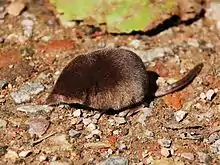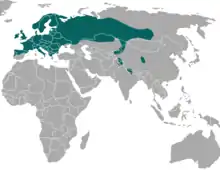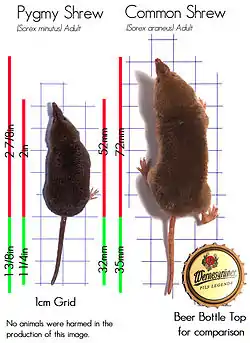Eurasian pygmy shrew
The Eurasian pygmy shrew (Sorex minutus), often known simply as the pygmy shrew, is a widespread shrew of northern Eurasia.
| Eurasian pygmy shrew[1] | |
|---|---|
 | |
| Scientific classification | |
| Kingdom: | Animalia |
| Phylum: | Chordata |
| Class: | Mammalia |
| Order: | Eulipotyphla |
| Family: | Soricidae |
| Genus: | Sorex |
| Species: | S. minutus |
| Binomial name | |
| Sorex minutus Linnaeus, 1766 | |
 | |
| Eurasian pygmy shrew range | |
Behaviour
Active throughout the day and night, the Eurasian pygmy shrew lives in undergrowth and leaf litter and lives off small insects and invertebrates.[3] It has an average weight of 4 grams, and has one of the highest metabolic rates of any animal; to maintain homeostasis, it must eat every two hours.[4][5]
Breeding
The breeding season lasts from April through to August. Females usually produce between two and eight young per litter and care for the young in an underground nest. Since the gestation period is just over three weeks, they can have up to five litters in one year, though the life span of a pygmy shrew is a little over 15 months.[3]
References
- Hutterer, R. (2005). Wilson, D.E.; Reeder, D.M. (eds.). Mammal Species of the World: A Taxonomic and Geographic Reference (3rd ed.). Johns Hopkins University Press. p. 292. ISBN 978-0-8018-8221-0. OCLC 62265494.
- Insectivore Specialist Group (1996). "Sorex minutus". IUCN Red List of Threatened Species. 1996. Retrieved 2006-05-12.CS1 maint: ref=harv (link)old-form urlDatabase entry includes a brief justification of why this species is of least concern
- "UK safari on Pygmy shrews". Retrieved 2007-12-27.
- "Phibius-log.blogspot.com — Sorex minutus". Retrieved 2007-12-27.
- Burton, Robert; Burton, Maurice (1970). The international wildlife encyclopedia. Marshall Cavendish. pp. 2358–2359. ISBN 0-7614-7266-5. Retrieved 22 December 2010.
External links
| Wikimedia Commons has media related to Sorex minutus. |
| Taxon identifiers |
|
|---|

